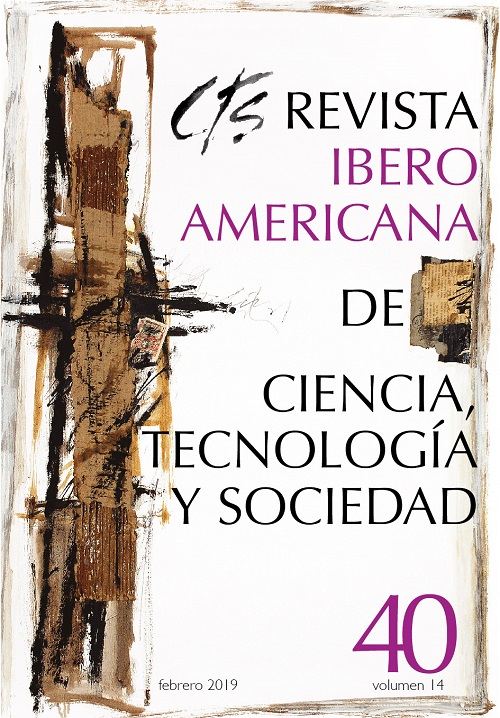Art, Science, Technology and Society. An Approach to Teaching and Learning the Sciences in an Artistic Context
Keywords:
art, science, technology, society, teaching and learningAbstract
Scientific teaching within the context of artistic education has characteristics associated to students and their ambiguous relationship with science and technology. Based on this statement, and within the framework of a doctoral research and an innovation project for teachers, a new approach is presented. It has been named “ASTS”: Arts, Science, Technology and Society. This paper analyzes the reasons for including the "A" in the already known STS approach as a teaching and learning methodology. Fundamental characteristics and the conceptual framework in which the proposal is entered are also noted. Finally, one of the projects carried out under the ASTS approach is detailed, as well as a qualitative analysis of the improvements in learning, motivation, expectations and interest experienced by the students.Downloads
References
AUSUBEL, D., NOVAK, J. D. y HANESIAN, H. (1978): “Changes in achievment goal orientations, perceived academic competence, and grades across the transition to middle level schools”, Contemporary Educational Psychology, vol. 22, n° 1, pp. 269-298.
BALL, P. (2004): La síntesis de los colores, México DF, Fondo Iberoamericano.
BOURDIEU, P. y PASSERON, J. C. (1977): La reproducción. Elementos para una teoría del sistema de enseñanza, Barcelona, Laia.
BROCKMAN, J. (1995): The third culture: Beyond the scientific revolution, Nueva York, Simon and Schuster.
CANADELL, E (2010): Art i ciència: converses, Barcelona, Publicacions i Edicions de la Unviersitat de Barcelona.
DEWEY, J. (2008): El arte como experiencia, Barcelona, Paidos Ibérica.
DEWEY, J. y BENTLEY, A. F. (1949): Knowing and the Known, Boston, Beacon Press.
EISNER, E. (1994): “Commentary: Putting multiple intelligences in context: Some questions and observations”, Teachers College Record, vol. 95, n° 4, pp. 555-560.
FUNDACIÓN ESPAÑOLA PARA LA CIENCIA Y LA TECNOLOGÍA (2006): El libro blanco de la interrelación entre Arte, Ciencia y Tecnología en el estado español, Madrid, FECYT.
GARDNER, H. (1971): “Problem solving in the arts and sciences”, Journal of Aesthetic Education, vol. 5, pp. 93-113.
GARDNER, H. (1991): The unschooled mind: how children think and how schools should teach, Nueva York, Basic Books.
GARDNER, H. (1999): Intelligence reframed: Multiple intelligences for the 21st century, Nueva York, Basic Books.
HARLAND, J., KINDER, K., LORD, P., STOTT, A., SCHAGEN, I., HAYNES, J., CUSWORTH, L., WHITE, R. Y PAOLA, R. (2000): Arts education in secondary schools: Effects and effectiveness, Londres, NFER, Slough.
JOUBERT, L. (2002): “La ciencia y el arte: Nuevos paradigmas en educación y salidas profesionales”, Revista trimestral de educación comparada, vol. 124, n° 4, París, Oficina Internacional de la Educación, UNESCO.
KLIMENKO, O. (2009): “La creatividad como un desafío para la educación del siglo XXI”, Educación y Educadores, vol. 11, n° 2. Disponible en:
http://educacionyeducadores.unisabana.edu.co/index.php/eye/article/view/740/1717.
LEDERMAN, N. G. (1992): “Student’s and teacher’s conceptions of the nature of sience: A review of the research”, Journal of Research in Science Teaching, vol. 29, n° 4, pp. 331-359.
LEYVA, R. (1989): “El principio de la relación íntermateria a través de la didáctica general y los métodos especiales”, Pedagogía Cubana, n° 5.
LOWENFELD, V. (1961): Desarrollo de la capacidad creadora, Buenos Aires, Kapelusz.
MARCOS, A. (2000): Hacia una filosofía de la ciencia amplia, Madrid, Tecnos.
MARCOS, A y CASTRO, S. (2010): Arte y Ciencia: mundos convergentes, Madrid y México DF, Plaza y Valdés.
MC COMAS, W. F., CLOUGH, M. O. y ALMAZORA, H. (1998): “The role and character of the nature of science in science education”, en W. Mc Comas (ed.): The nature of science in science education: Rationales and strategies, Boston, Kluwer Academic Publishers.
MILLER, A. I. (2007): Einstein y Picasso: El espacio, el tiempo y los estragos de la belleza, Barcelona, Tusquets
MORÍN, E. (1996): Introducción al pensamiento complejo, Barcelona, Gedisa.
MORAZA, J. L. y CUESTA, S. (2010): El arte como criterio de excelencia: programa campus de excelencia internacional: modelo ARS (Art, Research, Society), Madrid, Ministerio de Educación, Subdirección General de Documentación y Publicaciones.
READ, H. (1969): Educación por el arte, Barcelona, Paidós.
SNOW, C. P. (1969): The two cultures/A second look: An expanded version of the two cultures y the scientific revolution, Cambridge, University Press.
SONTAG, S. (1984): Contra la interpretación y otros ensayos, Barcelona, Seix Barral.
UNIVERSIDAD JOHNS HOPKINS (2009): Neuro-educación: Aprendizaje, las artes y el cerebro. Hallazgos y desafíos para los educadores e investigadores, Cumbre de la Universidad de Johns Hopkins, Nueva York, Dana Press.
WAGENSBERG, J. (2011): Más árboles que ramas: 1116 aforismos para navegar por la realidad, Barcelona, Tusquets.
WAKS, L. (1990): “Educación en Ciencia, Tecnología y Sociedad: orígenes, desarrollos internacionales y desafíos intelectuales”, en M. Medina y J. Sanmartín (eds.): Ciencia, Tecnología y Sociedad, Estudios interdisciplinares en la universidad, en la educación y en la gestión pública, Barcelona, Anthropos, pp. 42-75.
WALS, A. E., BRODY, M., DILLON, J. y STEVENSON, R. B. (2014): “Convergence between science and environmental education”, Science, vol. 344, n° 6184, pp. 583-584.
WINNER, E. y HETLAN, L. (2000): “The arts and academic achievement: What the evidence shows”, Journal of Aesthetic Education, vol. 34, n° 3/4, pp. 91-104.
Downloads
Published
How to Cite
Issue
Section
License
All CTS's issues and academic articles are under a CC-BY license.
Since 2007, CTS has provided open and free access to all its contents, including the complete archive of its quarterly edition and the different products presented in its electronic platform. This decision is based on the belief that offering free access to published materials helps to build a greater and better exchange of knowledge.
In turn, for the quarterly edition, CTS allows institutional and thematic repositories, as well as personal web pages, to self-archive articles in their post-print or editorial version, immediately after the publication of the final version of each issue and under the condition that a link to the original source will be incorporated into the self-archive.











